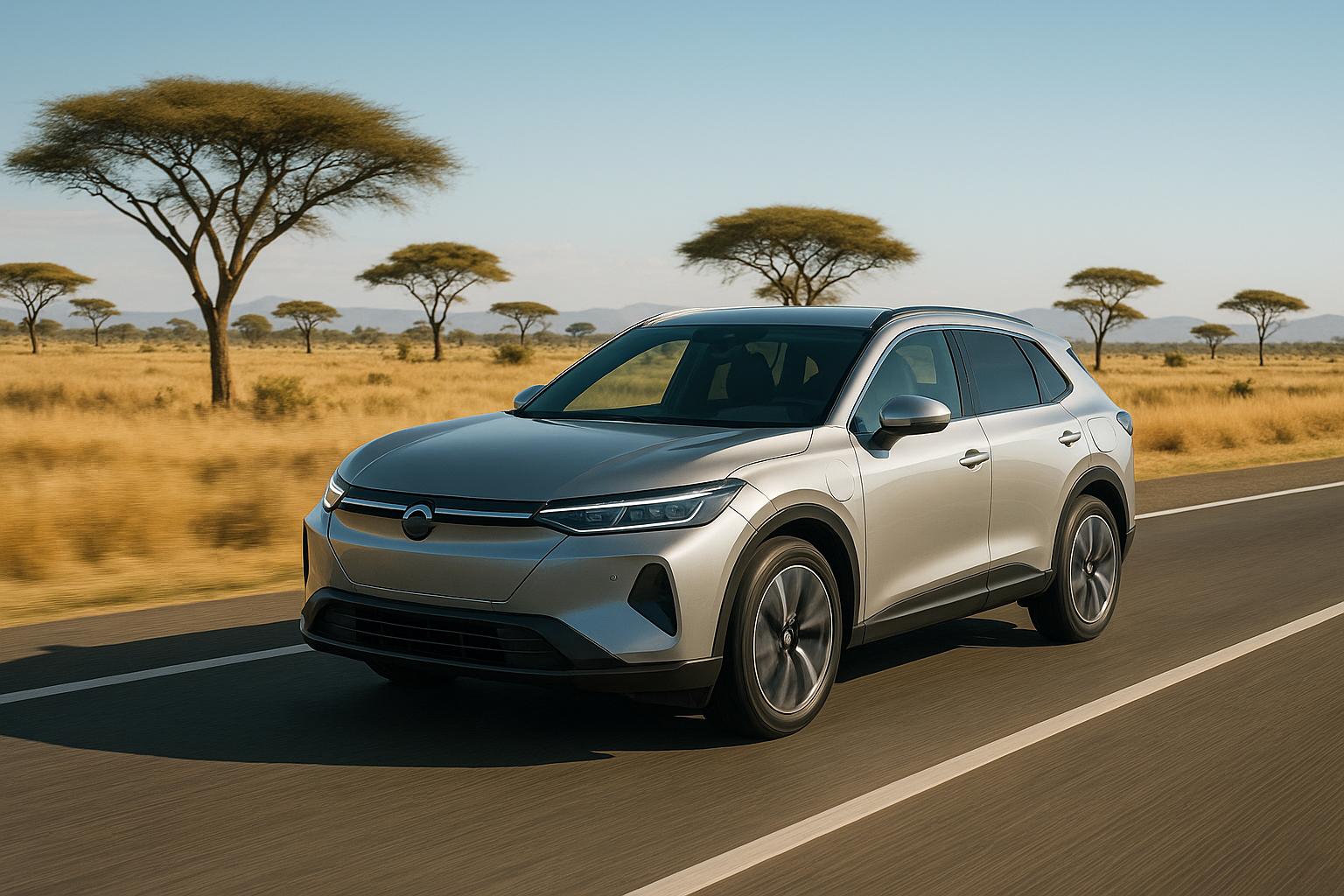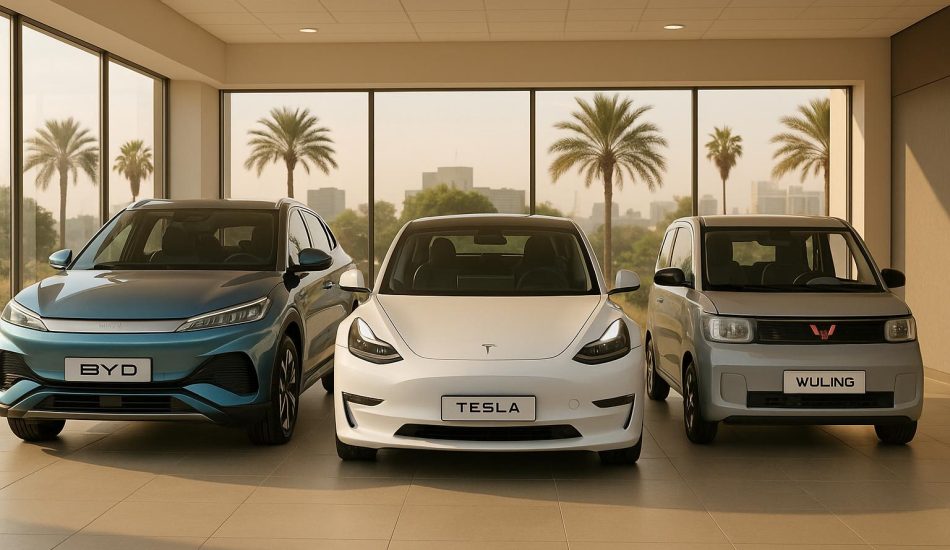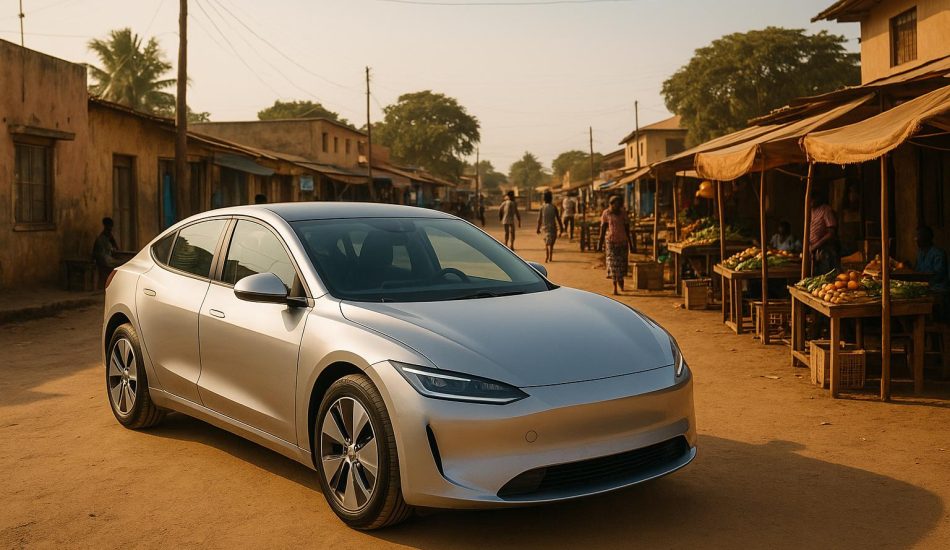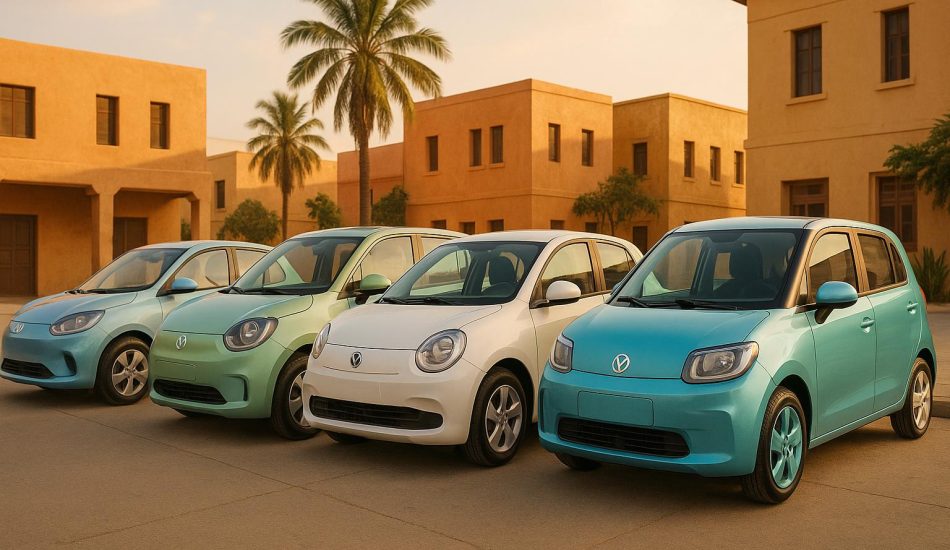
Plug-in Hybrid Electric Vehicles (PHEVs) are becoming a practical choice for African drivers in 2025. They combine a gasoline engine with a rechargeable battery, allowing short electric trips and gasoline backup for longer distances. Here’s why they stand out:
- Fuel Savings: Use electricity for daily commutes and reduce fuel costs.
- Flexible Charging: Charge at home, via solar, or rely on gasoline when needed.
- Best of Both Worlds: Unlike full EVs, PHEVs work well in areas with limited charging infrastructure.
- Eco-Friendly: Lower emissions during electric mode, improving air quality in cities.
Top models include the Toyota RAV4 Prime, BYD Tang DM-i, and Mitsubishi Outlander PHEV, each offering features suited for Africa’s driving conditions. Whether you’re navigating city streets or rural roads, PHEVs offer a reliable and efficient solution for modern transportation.
Omoda C9 PHEV South Africa – Full Drive, EV Range & Price!
Key Features and Benefits of PHEVs in the African Context
Plug-in hybrid electric vehicles (PHEVs) bring a mix of advantages tailored to Africa’s diverse driving conditions and evolving energy needs. They blend the cleaner operation of electric driving with the reliability of a gasoline engine, addressing many challenges drivers face across the continent.
Fuel Savings and Reduced Emissions
Using electric mode for shorter trips slashes fuel expenses since electricity is generally more affordable per mile than gasoline. In electric-only mode, PHEVs produce zero tailpipe emissions, which can significantly enhance air quality in crowded urban areas. Even when the gasoline engine is in use, hybrid systems are designed to operate more efficiently than traditional vehicles, resulting in fewer overall emissions.
By cutting down on fuel consumption, PHEVs reduce dependence on imported petroleum, keeping more economic resources within local economies. They also align well with the shift toward renewable energy sources, making them a practical option for Africa’s growing energy landscape.
Adaptability in Areas with Limited Charging Infrastructure
One of the standout features of PHEVs is their ability to adapt to regions with uneven charging infrastructure. Fully electric vehicles rely entirely on charging stations, but PHEVs can switch effortlessly between electric power and gasoline. This dual capability makes them suitable for both urban commuters and rural drivers.
Charging at home through standard outlets adds to their convenience. During power outages, drivers can recharge when electricity is restored and rely on gasoline in the meantime. For businesses and fleet operators, this flexibility ensures that operations remain uninterrupted, even in areas with inconsistent electrical supply.
Solar Charging Opportunities
Another advantage of PHEVs is their compatibility with renewable energy, particularly solar power. Africa’s abundant sunlight presents a chance for PHEV owners to use solar energy for charging. Residential solar systems can handle the smaller batteries of PHEVs more efficiently compared to fully electric vehicles. This not only reduces charging costs over time but also encourages the use of sustainable energy.
Solar charging also enhances energy independence. With a solar setup paired with battery storage, vehicle charging can continue even during grid disruptions. In rural or remote areas where electricity is unreliable or costly, solar-powered charging offers a practical and sustainable solution for modern transportation needs.
Top PHEV Models Available in Africa in 2025
The plug-in hybrid market in Africa has seen impressive growth in 2025, with manufacturers rolling out vehicles designed to meet the continent’s unique driving demands. These plug-in hybrids offer the convenience of electric driving paired with the reliability of a gasoline engine, making them ideal for city commutes and long trips across varied landscapes. Here’s a look at some of the standout models that balance efficiency with the practicality needed for African roads.
Model Features and Specifications
Toyota RAV4 Prime
The Toyota RAV4 Prime has earned a strong reputation for its durability and reliable performance, making it a favorite among African drivers. It seamlessly combines electric and gasoline power, offering versatility for both urban commutes and long-distance travel. With its proven track record and accessible service network, it’s a solid choice for those planning to keep their vehicle for years.
BYD Tang DM-i
The BYD Tang DM-i stands out with its extended electric range and competitive pricing. Its spacious interior and family-friendly design make it a practical option for larger households. Additionally, its growing presence in the market has boosted buyer confidence, offering a blend of affordability and functionality.
Mitsubishi Outlander PHEV
Built for drivers who navigate both city streets and off-road tracks, the Mitsubishi Outlander PHEV features advanced all-wheel-drive technology. Its rugged design ensures it can handle the unpredictable road conditions found in many parts of Africa, making it a dependable companion for diverse terrains.
Chery Tiggo 8 Pro PHEV
The Chery Tiggo 8 Pro PHEV delivers cutting-edge hybrid technology at a price point that appeals to budget-conscious buyers. With established distribution partnerships across West Africa, it has quickly gained popularity among those seeking modern features without breaking the bank.
Volvo XC60 Recharge
For those who value luxury and safety, the Volvo XC60 Recharge offers a premium driving experience. Packed with advanced safety features and European engineering, it combines comfort with the practicality of hybrid technology. It’s an excellent choice for drivers who want sophistication alongside efficiency.
These vehicles demonstrate how plug-in hybrids can cater to the diverse needs of African drivers.
Key Takeaways for African Drivers
Each of these models offers distinct advantages tailored to different priorities:
- BYD Tang DM-i: Ideal for daily commutes with its extended electric range, maximizing electric-only driving.
- Toyota RAV4 Prime: A reliable choice for long-term ownership, supported by a strong service network.
- Mitsubishi Outlander PHEV: Perfect for tackling challenging terrains with its superior all-wheel-drive system.
- Chery Tiggo 8 Pro PHEV: A budget-friendly option that delivers modern features and great value.
- Volvo XC60 Recharge: The go-to model for premium amenities and advanced safety technologies.
These options reflect Africa’s growing embrace of efficient and versatile hybrid vehicles, offering solutions for a wide range of driving needs.
sbb-itb-99e19e3
How to Get the Most from Your PHEV in Africa
Navigating Africa’s unique infrastructure can be challenging, but with the right approach, you can maximize your Plug-in Hybrid Electric Vehicle (PHEV) performance. By focusing on charging habits, driving techniques, and maintenance, you can adapt your PHEV to the region’s conditions for a smoother and more efficient experience.
Smart Charging Practices
If you have access to a home solar setup, take advantage of it for cost-effective charging. Charging during peak sunlight hours not only saves money but also aligns with renewable energy use. For those connected to the grid, scheduling your charging during off-peak hours can help reduce electricity costs.
When planning longer trips, public charging stations can be a lifesaver. Apps like ChargeMap and PlugShare are great tools to locate charging points in major African cities. By integrating these stops into your travel plans, you can ensure your PHEV remains powered up without hassle.
To prolong your battery’s lifespan, aim to keep it within the manufacturer-recommended charge levels. These small adjustments in charging habits can make a big difference in your vehicle’s overall efficiency.
Driving Techniques for Better Efficiency
Driving a PHEV efficiently requires a few tweaks to your usual habits. In stop-and-go traffic, make the most of regenerative braking. By easing off the accelerator as you approach stops, you allow the system to recover energy that would otherwise be lost.
Switching to Eco mode in urban areas can help you get more out of your electric range. Save the higher-performance modes for when you really need them, like overtaking or tackling steep inclines. Speaking of inclines, planning your routes with elevation changes in mind can be a game-changer. Tools that show elevation profiles can help you take advantage of downhill stretches for energy recovery, especially in regions with hilly terrain.
To reduce strain on the battery, pre-condition the cabin temperature while the car is still charging. And when parking, opt for shaded areas to keep the interior cool and minimize battery load.
Maintenance Tips for African Conditions
Keeping your PHEV in top shape is crucial, especially given Africa’s diverse and sometimes harsh environmental conditions. Regular maintenance is key to ensuring your vehicle performs well over time.
In dusty areas, air and cabin filters may need more frequent replacement to maintain efficient air circulation and interior comfort. Similarly, battery cooling systems require extra attention during hot weather. Regularly check coolant levels and make sure vents remain clear to protect the battery from overheating.
Tire pressure tends to fluctuate with temperature changes, so it’s important to check it regularly and adjust according to the manufacturer’s recommendations. Properly inflated tires not only improve efficiency but also extend their lifespan.
Don’t overlook software updates. Installing over-the-air updates can enhance battery management and overall vehicle performance. Additionally, local driving conditions might warrant adjustments to your service schedule, so consulting a dealer familiar with the region can be helpful.
Lastly, keep your charging ports clean. Dust and moisture can cause corrosion, which may disrupt charging. Regular cleaning ensures a reliable connection and consistent performance, even in challenging environments.
PHEVs and Africa’s Move to Electric Mobility
Africa is steadily transitioning toward electric mobility, and plug-in hybrid electric vehicles (PHEVs) are playing a key role in this shift. Instead of jumping straight to fully electric vehicles, many African nations are embracing PHEVs as a stepping stone. This approach allows for the gradual development of charging infrastructure, builds consumer trust, and helps local industries gain experience with electric vehicle technology. PHEVs are proving to be a practical solution for navigating the challenges of this transition.
PHEVs as Bridge Technology
PHEVs strike a balance between electric efficiency and the reliability of traditional fuel. While cities like Cape Town, Lagos, and Nairobi are making strides in expanding charging networks, rural areas often struggle with inconsistent electricity access. PHEVs address this gap by offering electric power for shorter trips and gasoline support for longer distances, easing concerns about running out of charge. This hybrid functionality allows drivers and service centers to familiarize themselves with electric systems without fully committing to battery-only vehicles. It’s a smoother way to introduce electric mobility into everyday life.
Current Policies and Market Trends
Governments across Africa are introducing policies to make PHEVs more accessible. Measures such as tariff reductions and tax incentives are helping to lower the cost of hybrid and electric vehicles. Additionally, programs aimed at easing financing and encouraging fleet upgrades are driving early adoption, particularly in urban areas where charging networks are more established. These efforts position PHEVs as an affordable and practical option for many African consumers.
Future Outlook for PHEVs in Africa
The future for PHEVs in Africa looks promising. Manufacturers are setting up local assembly plants to bring down costs and are designing vehicles that suit African conditions, such as models with better air filtration and cooling systems. Charging infrastructure is also expanding, with plans to build networks along major highways and in urban hubs.
Corporate adoption is gaining momentum, with industries like mining and ride-sharing incorporating PHEVs into their fleets. Financial institutions are stepping in with loan programs, and a growing secondary market is making these vehicles more accessible to a broader audience.
While fully electric vehicles may eventually dominate in cities with robust charging networks, PHEVs are likely to remain a top choice in rural areas and for long-distance travel. Their dual power systems make them a flexible option, ensuring they remain an essential part of Africa’s journey toward widespread electric mobility. Together, these developments highlight the critical role PHEVs play in bridging the gap to a fully electric future.
Conclusion
Plug-in hybrid electric vehicles (PHEVs) strike a balance between electric efficiency and fuel reliability, making them well-suited for Africa’s evolving charging infrastructure. They offer noticeable fuel savings, lower emissions, and the flexibility to handle both bustling urban streets and remote rural routes.
Thanks to their dual-power system, PHEVs are ideal for daily commutes in cities like Johannesburg while also being capable of long-distance travel between rural areas. When electric power isn’t enough, the gasoline backup ensures you’re never stranded.
Key Points Summary
Here’s what makes PHEVs stand out in Africa:
- Versatility: PHEVs combine the eco-friendly benefits of electric driving with the practicality of fuel-based systems. Charging is flexible – you can use standard home outlets, solar setups, or rely on gasoline when needed, making them accessible to a wide range of drivers.
- Environmental Impact: PHEVs are helping reduce urban air pollution, cut dependence on imported fuel, and introduce drivers to electric vehicle technology. As a transitional solution, they’re paving the way for fully electric mobility.
- Economic Opportunities: Beyond personal savings, PHEVs open doors for local industries, from vehicle assembly to maintenance and charging services. Government incentives and financing options are making them more affordable, while businesses adopting PHEVs showcase their reliability and cost efficiency.
Next Steps
If you’re considering a PHEV, start by assessing your driving habits and charging possibilities. Many African drivers find that PHEVs cover most of their trips on electric power alone.
Research available models, focusing on their electric ranges, fuel efficiency, and features. Don’t forget to evaluate warranties, service networks, and financing plans. The PHEV market in Africa is growing fast, with more models and better support emerging every year.
Platforms like EV24.africa are excellent resources for navigating your PHEV journey. They offer detailed model comparisons, buying guides tailored to African markets, and connections to trusted dealers and financing options. With expert advice, you can confidently choose a vehicle that fits your needs and location.
The shift to electric mobility is gaining momentum in Africa, and PHEVs are the perfect stepping stone for most drivers. They offer immediate benefits – whether it’s saving money, reducing emissions, or enjoying cutting-edge technology – while preparing you for a fully electric future. In today’s African context, PHEVs are a practical and forward-thinking choice.
FAQs
How do plug-in hybrid vehicles (PHEVs) help reduce fuel use and emissions in Africa?
Plug-in hybrid vehicles (PHEVs) are designed to cut fuel consumption and emissions by blending electric power with traditional engines. For short drives or daily commutes, PHEVs primarily rely on their battery, which helps reduce fuel usage and minimizes greenhouse gas emissions – something especially beneficial in crowded urban settings.
By decreasing dependence on fossil fuels, PHEVs not only help curb air pollution but also provide a practical option in areas where charging networks are still growing. This makes them a smart transitional choice on the path to fully electric vehicles, particularly in addressing the unique transportation challenges in Africa.
What are the benefits of using solar power to charge plug-in hybrid cars in Africa?
Using solar power to charge plug-in hybrid electric vehicles (PHEVs) in Africa comes with several important benefits. For starters, it offers a steady and accessible energy source, particularly in regions where the national power grid is either unreliable or unavailable. By turning to solar energy, reliance on fossil fuels decreases, and charging costs can be significantly reduced, making this option more budget-friendly over time.
On top of that, solar energy aligns with Africa’s renewable energy ambitions by cutting down carbon emissions and promoting cleaner energy solutions. It also opens doors for economic development, including the creation of jobs in the renewable energy industry, all while paving the way for a cleaner and healthier environment across the continent.
How can I keep my PHEV running efficiently in Africa’s unique driving conditions?
To keep your PHEV running reliably across Africa’s varied driving conditions, it’s important to stick to regular maintenance and adopt smart driving habits. Start by keeping a close eye on the cooling system, especially in hotter climates, to avoid overheating. Stick to the manufacturer’s service schedule – typically every 10,000 to 12,000 miles or once a year – for optimal performance. Also, try not to let the battery drain completely; maintaining a charge between 20% and 80% can help extend its lifespan.
If you’re driving in dusty areas or tackling off-road terrain, make it a point to clean your vehicle frequently. Dust and debris can accumulate and impact its performance over time. Don’t forget to make use of regenerative braking, which not only enhances efficiency but also helps reduce wear on your brakes. By following these straightforward tips, you can keep your PHEV dependable and efficient, no matter where the road takes you.




